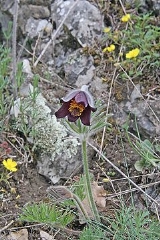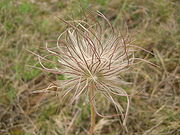
Meadow Anemone
Encyclopedia
Pulsatilla pratensis is a species of the genus Pulsatilla, native to central and eastern Europe
, from southeast Norway
and western Denmark
south and east to Bulgaria
. It grows from near sea level in the north of the range, up to 2,100 m in the south of its range.
It is a herbaceous
perennial plant
growing to 8–30 cm tall. The leaves
are finely divided and thread-like, and densely covered with silvery hairs. The flower
s are 2-3 cm long, pendulous, bell-like, the tepal
s with reflexed tips; flower colour varies from purple in the north of the species' range to greenish-violet in the south. The flowers are hermaphrodite
, and are pollinated by bees; flowering is from early to mid spring.
There are four subspecies
:
 Pulsatilla pratensis subsp. hungarica is endemic to Hungary
Pulsatilla pratensis subsp. hungarica is endemic to Hungary
, where it is protected by law. It occurs on open sand-plains and avoids limestone, and can only be found in two regions of Hungary, the Nyírség and Bodrogköz.
or drying. It has medicinal uses, and can be used externally to cure ulcers and inflammation in the eyes. It is especially useful in the treatment of children and infants.
Europe
Europe is, by convention, one of the world's seven continents. Comprising the westernmost peninsula of Eurasia, Europe is generally 'divided' from Asia to its east by the watershed divides of the Ural and Caucasus Mountains, the Ural River, the Caspian and Black Seas, and the waterways connecting...
, from southeast Norway
Norway
Norway , officially the Kingdom of Norway, is a Nordic unitary constitutional monarchy whose territory comprises the western portion of the Scandinavian Peninsula, Jan Mayen, and the Arctic archipelago of Svalbard and Bouvet Island. Norway has a total area of and a population of about 4.9 million...
and western Denmark
Denmark
Denmark is a Scandinavian country in Northern Europe. The countries of Denmark and Greenland, as well as the Faroe Islands, constitute the Kingdom of Denmark . It is the southernmost of the Nordic countries, southwest of Sweden and south of Norway, and bordered to the south by Germany. Denmark...
south and east to Bulgaria
Bulgaria
Bulgaria , officially the Republic of Bulgaria , is a parliamentary democracy within a unitary constitutional republic in Southeast Europe. The country borders Romania to the north, Serbia and Macedonia to the west, Greece and Turkey to the south, as well as the Black Sea to the east...
. It grows from near sea level in the north of the range, up to 2,100 m in the south of its range.
It is a herbaceous
Herbaceous
A herbaceous plant is a plant that has leaves and stems that die down at the end of the growing season to the soil level. They have no persistent woody stem above ground...
perennial plant
Perennial plant
A perennial plant or simply perennial is a plant that lives for more than two years. The term is often used to differentiate a plant from shorter lived annuals and biennials. The term is sometimes misused by commercial gardeners or horticulturalists to describe only herbaceous perennials...
growing to 8–30 cm tall. The leaves
Leaf
A leaf is an organ of a vascular plant, as defined in botanical terms, and in particular in plant morphology. Foliage is a mass noun that refers to leaves as a feature of plants....
are finely divided and thread-like, and densely covered with silvery hairs. The flower
Flower
A flower, sometimes known as a bloom or blossom, is the reproductive structure found in flowering plants . The biological function of a flower is to effect reproduction, usually by providing a mechanism for the union of sperm with eggs...
s are 2-3 cm long, pendulous, bell-like, the tepal
Tepal
Tepals are elements of the perianth, or outer part of a flower, which include the petals or sepals. The term tepal is more often applied specifically when all segments of the perianth are of similar shape and color, or undifferentiated, which is called perigone...
s with reflexed tips; flower colour varies from purple in the north of the species' range to greenish-violet in the south. The flowers are hermaphrodite
Hermaphrodite
In biology, a hermaphrodite is an organism that has reproductive organs normally associated with both male and female sexes.Many taxonomic groups of animals do not have separate sexes. In these groups, hermaphroditism is a normal condition, enabling a form of sexual reproduction in which both...
, and are pollinated by bees; flowering is from early to mid spring.
There are four subspecies
Subspecies
Subspecies in biological classification, is either a taxonomic rank subordinate to species, ora taxonomic unit in that rank . A subspecies cannot be recognized in isolation: a species will either be recognized as having no subspecies at all or two or more, never just one...
:
- Pulsatilla pratensis subsp. pratensis
- Pulsatilla pratensis subsp. bohemica Skalický
- Pulsatilla pratensis subsp. hungarica Soó
- Pulsatilla pratensis subsp. nigricans (Störck) Zämelis

Hungary
Hungary , officially the Republic of Hungary , is a landlocked country in Central Europe. It is situated in the Carpathian Basin and is bordered by Slovakia to the north, Ukraine and Romania to the east, Serbia and Croatia to the south, Slovenia to the southwest and Austria to the west. The...
, where it is protected by law. It occurs on open sand-plains and avoids limestone, and can only be found in two regions of Hungary, the Nyírség and Bodrogköz.
Cultivation and uses
This plant is toxic, but can be dissipated through heatHeat
In physics and thermodynamics, heat is energy transferred from one body, region, or thermodynamic system to another due to thermal contact or thermal radiation when the systems are at different temperatures. It is often described as one of the fundamental processes of energy transfer between...
or drying. It has medicinal uses, and can be used externally to cure ulcers and inflammation in the eyes. It is especially useful in the treatment of children and infants.

